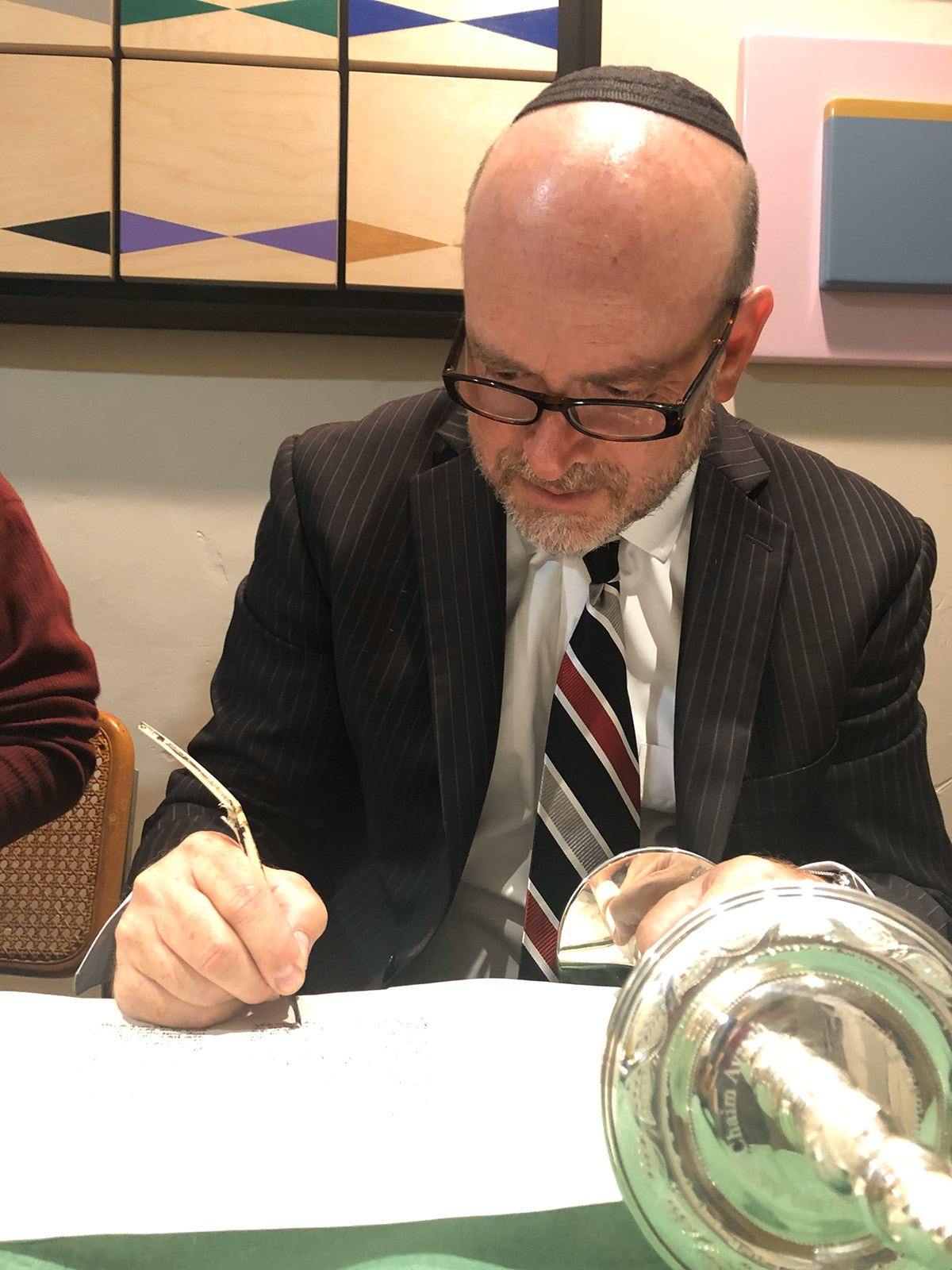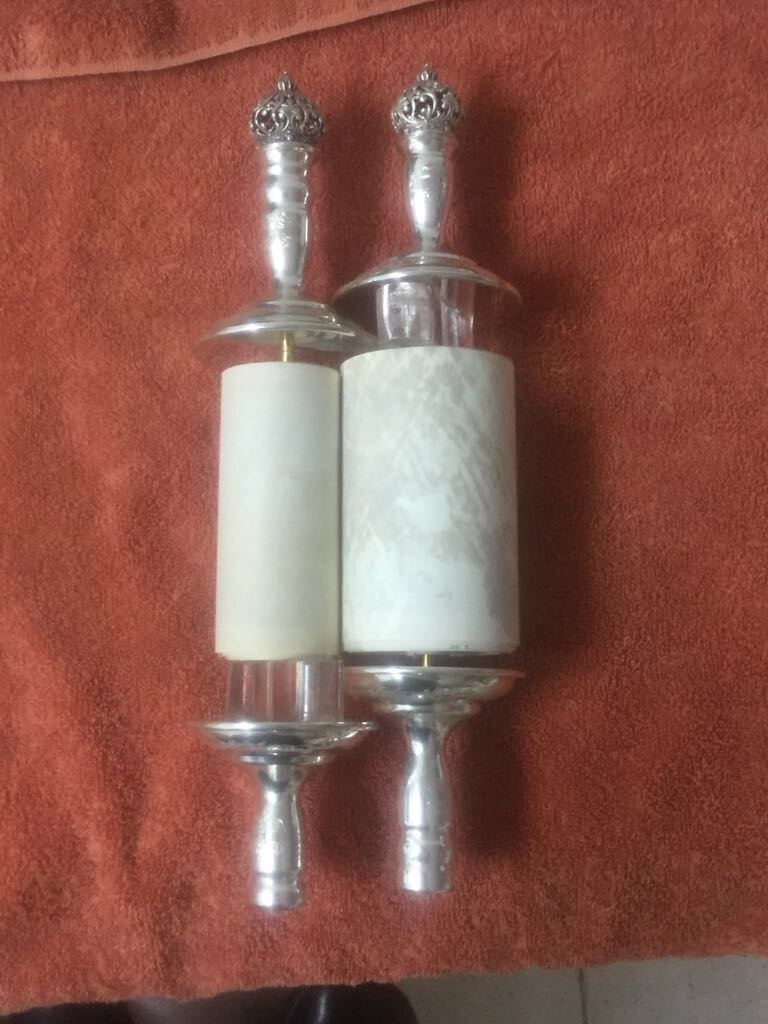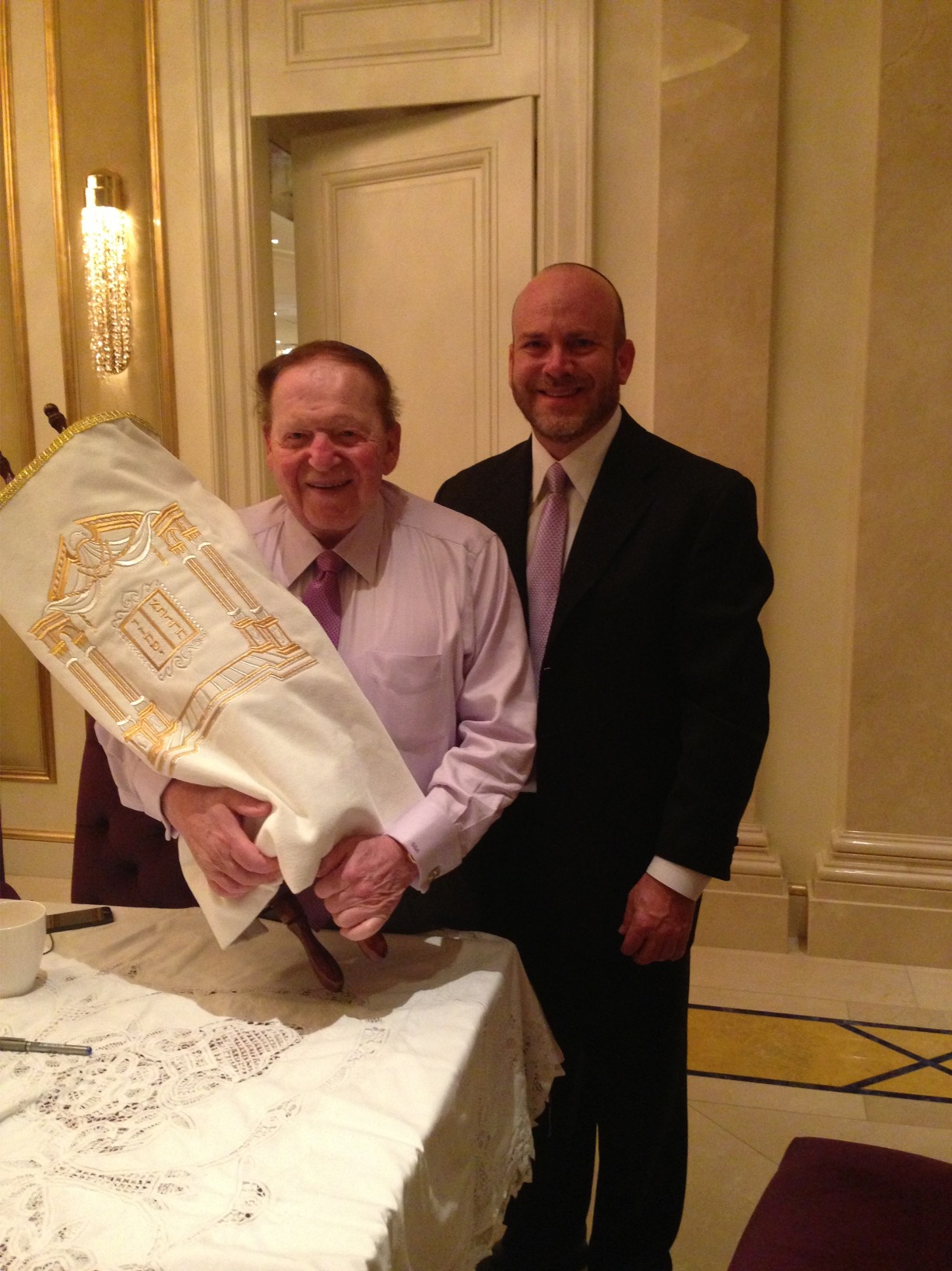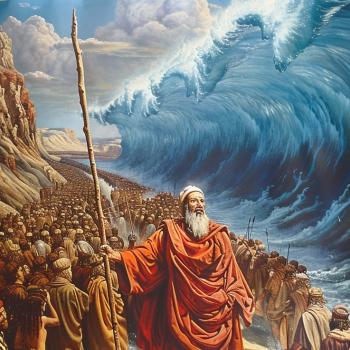
“Religion Behind the Scenes” with Jewish Sofer, Ronnie Sieger
Religion Behind the Scenes spotlights the less discussed, but no less crucial, tasks that keep religious communities running, and the people who make it all happen.
Most of the world’s major religious traditions have scriptural texts used by leaders and laity alike. Those texts are traditionally printed and bound using machines, and then distributed, as needed, to those who wish to read them. However, Judaism is unique in that it has commercially produced scriptural texts (used by the laity), but also handwritten sacred texts (necessary for liturgical purposes in the synagogue).
Scribes, called “sofers,” write out—entirely by hand—certain sacred texts, including the copy of the Torah (or five books of Moses) used in synagogues. The 304,805 Hebrew letters found on a Torah scroll are inscribed on a parchment (or klaf) made from the skin of a kosher animal, such as a cow, goat, or deer. Having worked as a sofer for more than 30-years, Ronnie Sieger shares with us some of the “behind the scenes” aspects of the work of Jewish scribes.
If someone asked you what a sofer is, how would you explain your job?
Yeah, I have to do that occasionally. I will often explain that there are important Jewish ritual objects. And I basically write them, maintain them, and make sure they’re all in proper order. Sometimes I will point out that, if they have ever seen a mezuzah on a doorpost in a Jewish home, I take care of those little things. There is a small handwritten scroll inside of each of those, and I make sure they’re kosher, and make sure they’re written properly. And, in the synagogues, there are these big scrolls—the Torah scrolls—and I actually write, maintain, or repair those to make sure that they’re properly written and in proper condition.
So, what all does a sofer traditionally scribe?
We do Torah scrolls used in synagogues, along with the occasional privately owned one. And I personally also scribe and repair mezuzah scrolls, and Megillah scrolls (for Purim), in addition to the small scrolls in the tefillin.
So, how long have you been doing this kind of work?
I became a certified sofer or scribe in 1989.
And what does it take to become certified as a sofer?
So that’s a very good question because there are no Sofer Schools or Academies as of right now. Technically, if you want to be a certified scribe or sofer, it is basically as simple as someone who is qualified saying, “I’ve tested this person and I certify this person. This guy’s a qualified sofer.” That’s basically all you need. But nowadays, sometimes people want something on paper. So, there’s an organization called Vaad Mishmereth Stam that certifies people. They’re recognized by a lot of people, but not necessarily others. But some people say if you have that kind of certificate from them, it kind of makes you good. They give you this book, all written in Hebrew, of course. They give you all of the questions, but you have to do the research to know all of the answers for it. And then they test you on these questions, and you have to get over 90%. And then there’s an oral test as well. So, I got a certificate from them for passing their written exam.
Funny story. I went to Israel to go learn to be a sofer, because I was working for a scribe, and he wanted me to be qualified to help. So, I went to Israel to take a six-week course. The sofer there taught me how to write and taught me all the laws. There are books that teach you how to write, what to do when you’re writing, and how to do corrections. Well, at the end of six weeks, I said to the sofer training me, “When do I become certified?” He goes, “Well, I’m not certified, officially.” I go, “What do you mean?” He says, “This Rabbi taught me, and he said, ‘Good job’—and everyone trusts me to do my job, so, I didn’t feel the need to get certified.” Well, I wasn’t sure that was gonna fly in Los Angeles. But to be honest, I don’t think anyone’s actually asked for proof that I’m certified.
So, I went to Vaad Mishmereth Stam, and they say go to Rabbi Yaakov Siegel, who lives in Israel, and he’ll teach you and whatever. So, he taught me, and tested me, and he certified me himself. He himself was certified by a very important Rabbi in Jerusalem. So, I thought that was good enough.
You mentioned the “laws” of scribing. Can you give me an example of a law that sofers need to know and follow?
Yeah, so there’s a simple law, for example, when you write God’s name. You can never erase it. So, if you make a mistake writing HaShem, you’re not allowed to scrape it out—to try to erase it. Also, you have to make sure that letters aren’t touching, and things like that. So, there are a lot of little things that you have to learn to be a sofer. It’s not enough to just have nice Hebrew penmanship.
What got you into this work?
I’ve been a practicing Orthodox Jew my whole life. I’ve kept mitzvot. When I went to Israel, I became a little Haredi. I got very religious, you know. I had a rabbi, when I came back to LA, that said to me, “Calm down a little bit, relax, and don’t look around and think everyone is a sinner,” you know. So, after Israel, I started thinking, well, “What do you do when you’re really religious and you want to do something Jewish?” You become a rabbi, right? So, I started teaching, but I was too much of a softy. I like being the kids’ friend, but it is very hard for me to lay the hammer down when there are discipline problems. And also, there are certain aspects of learning that are very important to be a rabbi. I didn’t have the patience for learning the Talmud which, of course, is required to be a good Orthodox rabbi. So, I just had to look for something else.
A friend of mine in LA happened to be a sofer. There was only one or two of them in the whole city at the time. So, I said to my friend, “Do you have a job for me? I want to do something Jewish.” So, I started working for him and I liked the work. It kind of fit me. I just had to figure out how to make a living doing it—because my friend wasn’t making much as a sofer. So, after about a year of working for my friend, I went out on my own. That was in 1991.
Tell me about the quill used to write of the scrolls.
Well, for repairs on damaged scrolls, you use a technical pen. It’s a micron pen or a Koh-I-Noor rapidograph pen. There’s an ink cartridge in it. They’re expensive pens, but very precise. If you want to write with a quill, it’s actually very difficult to make corrections and do fine lines with those. So, these pens have been approved for many years. That’s what we typically use for corrections.
But anytime someone’s writing from scratch—writing a Torah scroll, a mezuzah scroll, tefillin scrolls—we use a quill. It’s usually a turkey feather. Some sofers, in places where they didn’t have access to turkey feathers, would use a bamboo reed. But usually the quills were a turkey feather or a goose feather.
Can you describe for me, Ronnie, a typical day in the life of a sofer?
Well, when you walk into my office, there’s a big table—and that pretty much always has a Torah scroll on it. I’m always working on a Torah scroll, one way or another.
I spend a lot of time repairing scrolls, so I sometimes call myself “The sofer that doesn’t write.” Obviously, I write, I know how to write; but these days I mostly do inspections and repairs of scrolls. So, for example, there’s the Torah on the table here. New Torah scrolls costs around $40,000 and old Torah scrolls cost closer to $15,000 or $20,000. So, very often I get requests from people who say to me, “I can’t afford $40 thousand. Let me see if I can afford a used Torah.” So, in the case of this Torah on my table right now, I was able to purchase an old scroll from someone that didn’t want to use it anymore. It was in a state of disrepair. So, I take it and restore it, and then sell it as used scroll.
I spend most of my days sitting at my table, writing—usually repairing portions of the writing on a scroll that has gotten damaged or scraped off. That’s very common. There are over 300,000 letters in the Torah. So, if you have several 100 letters coming off, you have to fix every single letter, rewriting them. It’s not a kosher Torah if the letters are missing. So, I spend the bulk of my days making sure that all of these scrolls are kosher. You can see, I have an entire wall of scrolls here. So, a Torah is always on my desk. And I am either inspecting them to make sure they are kosher, or I am repairing them to make sure they are kosher.
In addition to that, people come into my office all day long. They want to buy a mezuzah, or they want me to check their mezuzah—so they bring them, and I unroll the scrolls and check to make sure they’re good. Or, if they need a new scroll, I replace theirs with a new one. People also come to me to check their tefillin, because the boxes can warp or the straps can wear out, and they want to make sure the scrolls are good inside. So, I check those as well. You know, some days I’ll have the Torah on my desk, and I don’t even touch it. I’m too busy with people bringing me other stuff to do, which is okay. But this is what I do.
Do you roll it out and look at a whole section, or do you have to carefully look at every line?
I’m basically looking at every line, because every letter has to be kosher. But let’s say I’m looking through a newer scroll, I can sort of scan it and see with my eyes if there are imperfections or damage. But then, once you start seeing a couple of things, you have to slow down a bit. So, the older the Torah is, the more you have to be careful when you inspect it.
How hard is this work on your body?
Yeah, it can be rough. Whenever I’m writing for a long time, I’ll experience some tension in my arm. I’m kind of wearing out my forearm a bit. I’m just doing very delicate repairs all of the time with my hand, and so things like tendonitis or carpal tunnel can definitely happen.
What would you say is the most sacred side of what you do?
That’s an interesting question. I remember first being most intimidated by Torah scrolls, because that’s where everything comes from. So, when I first started, I was afraid to make one little correction in the Torah. I was like, “I can’t believe I’m doing this.” Whenever you’re working on a scroll, you always say in Hebrew, “I'm doing this for the sake of the holiness of what I’m doing.” So, I guess I would probably say the most sacred part of my work is that I am writing God’s word.
I’m not superstitious, and I don’t want to turn my work into some kind of Voodoo, but people get touched by what I do. So, for example, I had sold a man a nice new pair of tefillin. Later he told me, “Right when I put on those tefillin you made me, I got a call and was offered a new job that gave me a lot more income. Thank you for the new tefillin.” I told him, “I’m just doing my job, but I’m glad it worked out for you.” I feel a lot of responsibility to make sure people’s mezuzahs are kosher, cuz they obviously mean a lot to these people. So, I’m sensitive to that. I take it seriously when what I do might affect people’s lives.
In order to be kosher, a Torah scroll doesn’t have to be written without the sofer making any mistakes—correct? You just have to correct any mistakes that have been made. Is that right?
Right. The sole exception to that is that you can’t make a mistake writing God’s name, and then erase and repair that. So, as an example, I was inspecting a scroll, and there was a mistake where the sofer was supposed to write the letters yud hey yud hey, but he wrote yud hey and then vav hey, which is God’s name. It was a typo, but it couldn’t be repaired. So, I had him take the whole lengthy three-column section out and rewrite that entire section, sewing it into the scroll where the parchment with the typo had been.
They actually scan each mezuzah scroll after the sofer writes it, and there’s a little label that says it’s been checked by computer. The scan shows if there are any letters touching or any letters missing. And we do that with tefillin scrolls too, to make sure that they’re kosher. But sometimes the computer will say that there’s something wrong with the scroll, but the person scanning it will just forget to look at the computer screen. So, there are times when I will check a scroll, and there are letters missing, even though it has been scanned for accuracy. Torah scrolls get scanned too, which lets us know where any mistakes are that need to be corrected.
What would you say you’re most proud of in your work?
What I really like is that people are always interested in what I do. I like doing something that people find fascinating. It’s nice to do that. It reminds me of that movie, “City Slickers,” where Billy Crystal was selling advertising spots and he asks, you know, What am I doing? What kind of purpose do I have? Like, I just sell advertising. I feel that what I do really has purpose. It has meaning. It’s a nice feeling to know that what I do is something that people appreciate and that I’m helping people fulfill the mitzvahs properly. It gives me satisfaction.
All of all of the things you do, as a sofer, what do you prefer to work on?
So, I had a very fun project. I worked on this Torah for a guy for almost two years. His family had brought it from Poland before the war. They saw the writing on the wall, they saw that Hitler was on his way. So, they left Poland and they brought it over to the United States in the 1930s, late 30s. And the family had kept it all those years. The parchment was in good shape, but all the letters were pretty much falling off. It was a big job to restore it. I think I originally estimated it would take about $45,000 to fix the whole thing, because I basically had to rewrite the whole Torah by hand. I worked on it every day. When I finished, it looked beautiful, and I helped to create that beauty. I was restoring something that was over 100 years old, and that was going to be put into use again. It really was one of my biggest, happiest projects that I’ve worked on.
The man who brought that scroll in for me to restore mostly did it because his grandson was going to have his Bar Mitzvah, and the grandfather wanted to use that Torah (passed down in his family) for his grandson’s Bar Mitzvah. And the fact that he dedicated over $60,000 to fix it, and he trusted me… I just loved that project.
Do you have an unusual story related to what you do?
I have a kind of interesting story. Sheldon Adelson, the Jewish billionaire, was having a birthday. His wife, Miriam, wanted to get him a special gift. She told me, “I want to buy my husband a Torah for his birthday. He will be eighty. Do you have an eight-year-old Torah?” Well, it’s very hard to find an old Torah that you know exactly when it was written. So, I told her, “Get a new Torah scroll for him.” She said, “Okay, his birthday is Thursday.” That was in four days. It takes up to two years to produce one of these. She asked me, “Can you get me one by Thursday?” So, I immediately made a bunch of phone calls to all my contacts who might have new Torah scrolls already to go. And, sure enough, someone had one. Of course, the Torah isn’t completely finished, because I do the last letters with the new owner. So, it was mailed to me on Monday, and it got here Wednesday. On Thursday, I drove out to bring it to them, and to finish the last few letters of the Torah for them on his eightieth birthday.
What's behind that tradition of leaving the last few letters blank until the new owner receives the Torah?
When someone writes a new Torah, they leave unfinished the last few letters. And then the sofer and the new owner write the last few letters together. It’s kind of like we’re completing the Torah together. We’re all supposed to be involved in writing the Torah. The 613th mitzvah (Deuteronomy 31:19) says that every Jew is obligated to write a Torah. So, if you write the last few letters, we say “you’ve written a Torah.” And if you’ve hired someone to write a Torah, or you can’t afford that so you hire someone to write a letter in the Torah, we kind of count that as well. It’s a very touching ceremony. When people are writing those last letters with me, they’re crying. It’s very inspirational.
There are those who actually want take the sofer’s quill and try to write the letter themselves. I’m kind of like, “Please don’t!” Just hold my arm as I write. That’s count. I had an experience where we were finishing a Torah, and the rabbi was in charge of doing the last letter, and he kind of flubbed it. I was able to repair it but, no matter how important the person is who wants to write the letter, just please let me do it. As they say, “Don’t try this at home,” you know? So, I pretty much insist that they just hold my hand while I do it.
What’s the most common thing, either positive or negative, that you’ve run a run up against, with regards to what you do?
Well, a good thing about what I do is that people don’t usually bounce checks when buying this kind of stuff. In this kind of business, fortunately, I don’t have to deal with a lot of crooked people. There’s like the karma involved. You don’t want to be dishonest about this kind of stuff. So, I don’t usually have to deal with people who, for example, buy a mezuzah but then don’t pay me. If they’re buying something like this, most people don’t want to mess around.
Are there misconceptions about the work of a sofer that some people might have?
Well, some think that you have to go to the mikveh every day if you’re a sofer. Some think you have to go every time you write God’s name, which is not true. To do that, you’d probably need a mikveh in you house, or a stream in your yard. So, that’s a misconception. Even if you’re a person that writes, not just repairs, you don’t have to immerse in a mikveh every day. I know sofers who don’t. But that’s something usually Hasidim do.
Also, sometimes people don’t know all the laws. So, they’ll say something like, “Oh, if a letter is not written properly, you have to throw away the whole Torah.” Well, obviously not. Or they’ll say, “Oh, you have to burn it when it’s too damaged to repair.” No, actually you bury it. So, the burning thing is a weird misconception people have. Sure, sometimes a scroll is in really bad shape, so you then bury those sections that can’t be repaired, but you don’t have to bury the whole thing.
How is this work changed you for the better or influenced you spiritually?
I think it helps me to have good behavior. It keeps my behavior in line. Because I am a sofer, I have to be an example to people. Not that I would, but it can keep me from doing things that I shouldn’t be doing. It kind of puts me in a position where I feel responsible to be a good example of what I do.
Do you see any significant changes coming in the future for those who will take up this occupation?
I don’t really. At one point they came up with an idea that Torahs could be written by something like a computer hand. But it was determined that that would not produce a kosher Torah. And there was someone who came up with the idea of putting a plate down on the parchment, like a serigraph, and then smearing ink over it. But that too was rejected. So, I don’t see any significant change coming in what sofers do, in the art of what we do. Any changes will be more on the business end—how you run your business, having a website—things like that. All the stuff that has to be done by hand is never going to change.
Is there anything else you think people should know about the work of a sofer?
Well, people always think of a sofer as someone who writes. So, I always have to explain that I’m not just the person who’s writing, but I’m also here making sure everything is done properly. Just because it is handwritten doesn’t mean it’s kosher or usable. So basically, I’m here for you, for the community, to make sure everything’s done properly. So, that’s a misconception that most people have when they think about the work of a sofer.
Interview conducted, transcribed, edited, and condensed by Alonzo L. Gaskill.
ABOUT ALONZO L. GASKILL, PH.D.
Alonzo L. Gaskill is an author, editor, theologian, lecturer, and professor of World Religions. He holds degrees in philosophy, theology/comparative religion, and biblical studies. He has authored more than two-dozen books and numerous articles on various aspects of religion; with topics ranging from world religions and interfaith dialogue, to scriptural commentaries, texts on symbolism, sacred space, and ritual, and even devotional literature.
7/13/2022 10:01:40 PM










